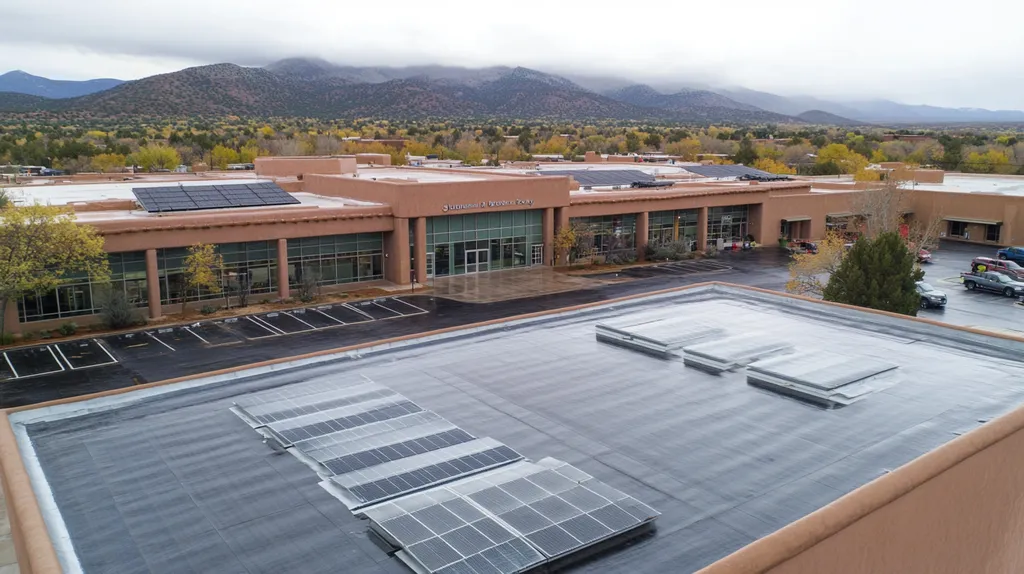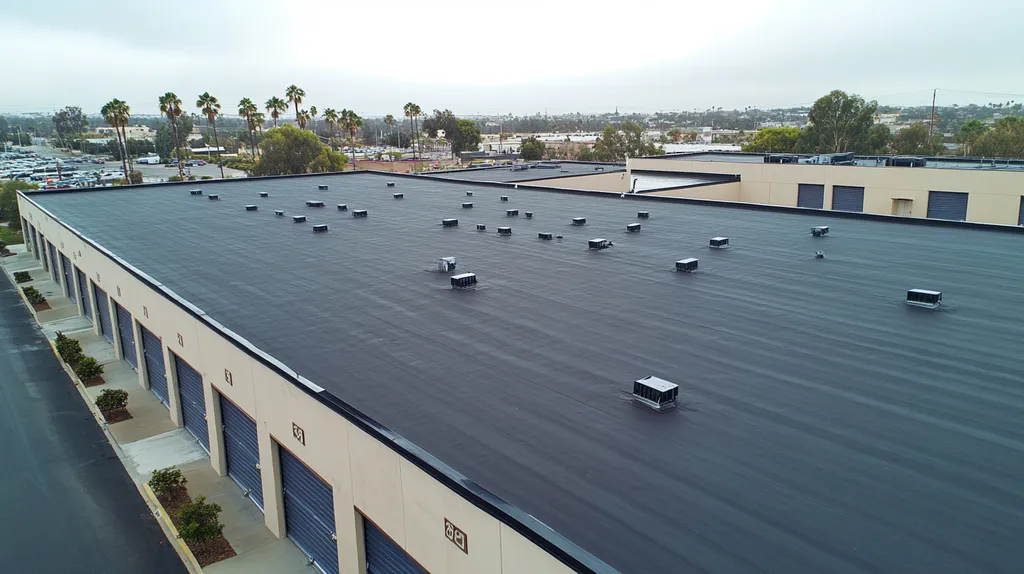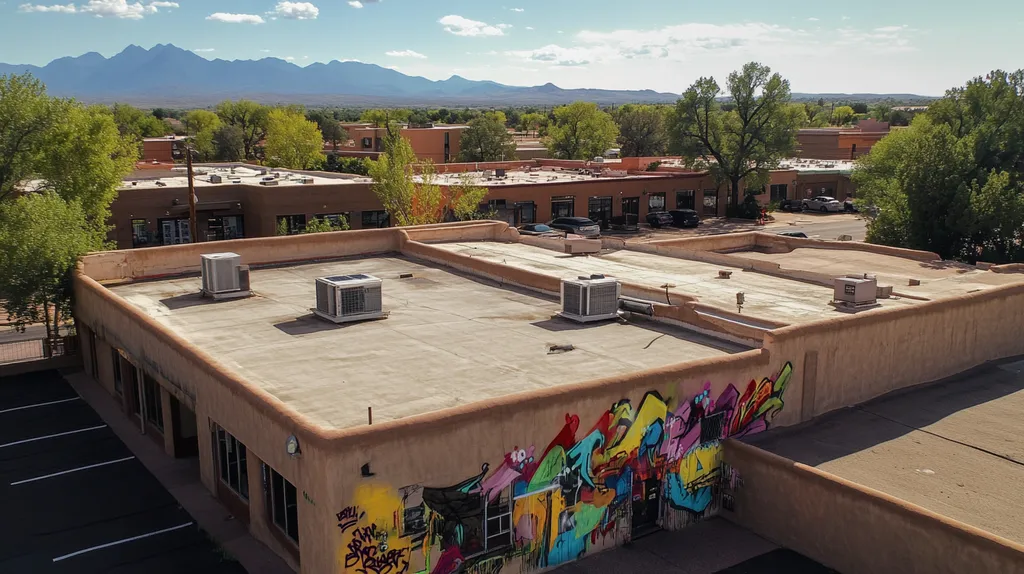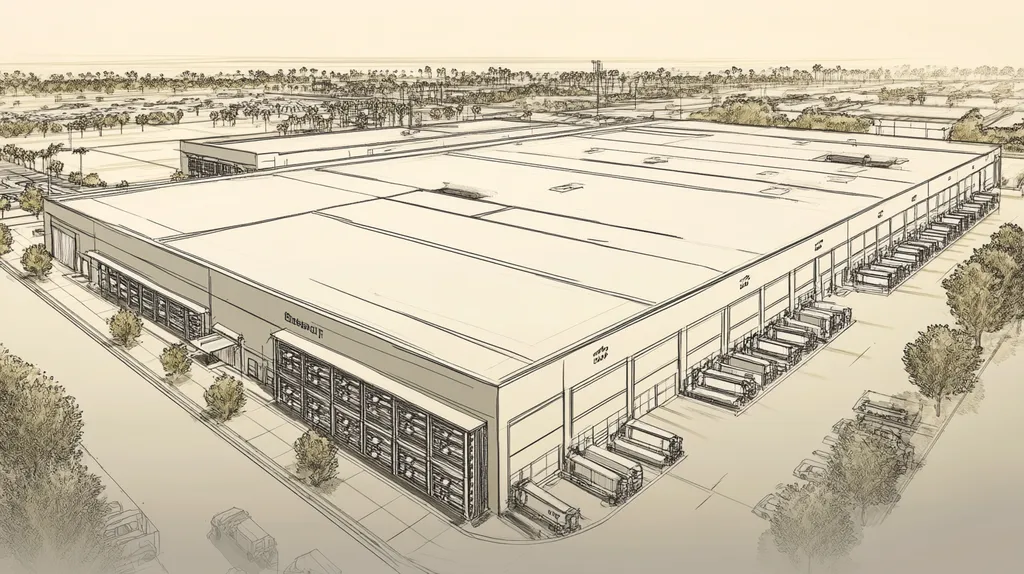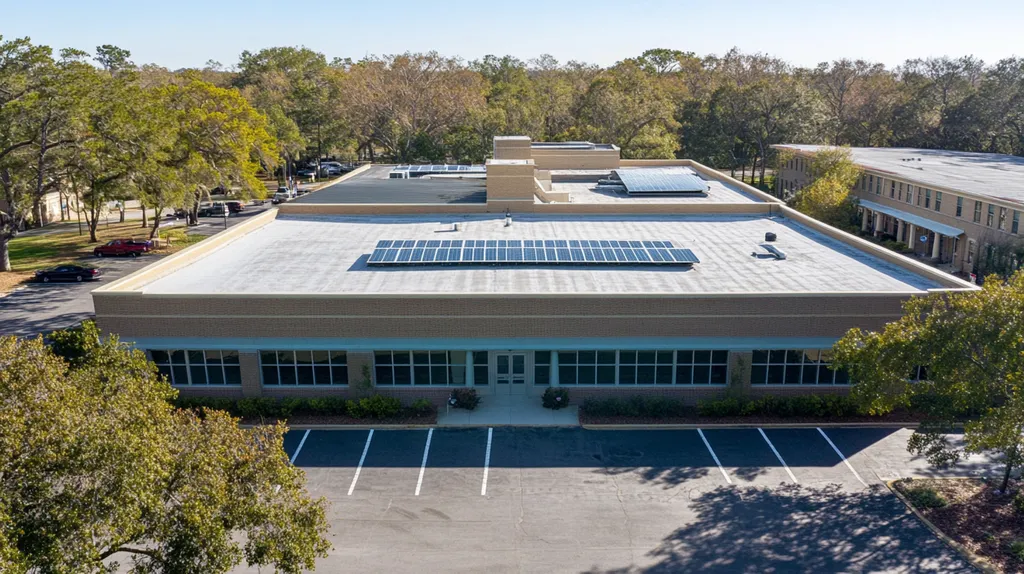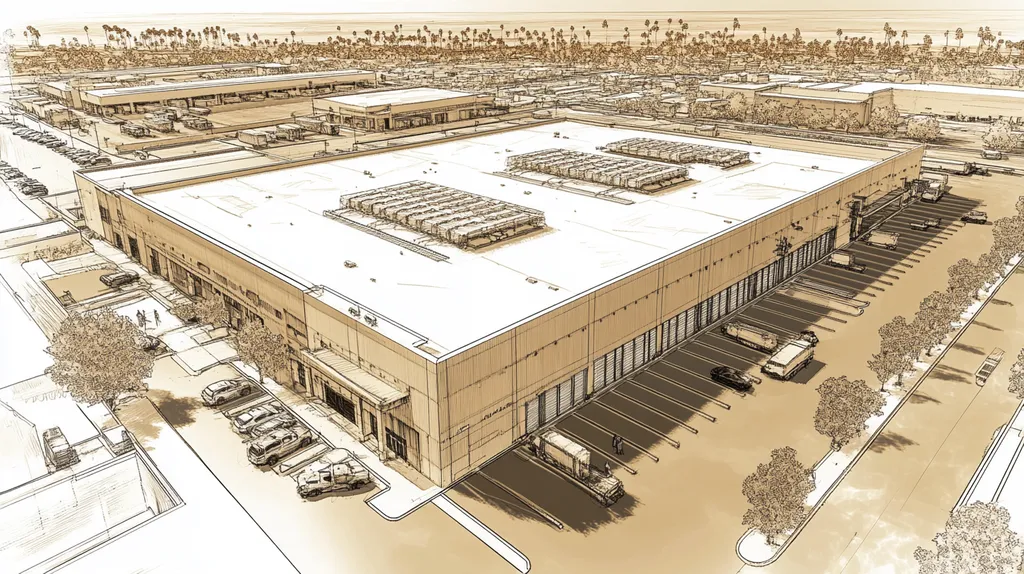In commercial roofing, dust isn’t just a nuisance—it’s a silent saboteur that can slash coating adhesion rates by up to 50% and trigger premature system failures. Despite this stark reality, over 70% of property managers underestimate dust’s impact on their roofing investments.
From compromised waterproofing to skyrocketing energy costs, the consequences of poor dust control ripple through every aspect of building performance.
This comprehensive guide unveils the truth about dust control in commercial roof coating, exploring common misconceptions, practical implications, and evidence-based solutions that can save facilities thousands in preventable repairs.
SECTION 1: COMMON MISCONCEPTIONS
When it comes to dust control in commercial roof coatings, many misconceptions float around, and those misunderstandings can have serious repercussions on roofing performance. Research indicates that inadequate dust management can slash adhesion rates by up to 50%, resulting in coating systems that fail prematurely. Unfortunately, many property owners dismiss dust as a mere annoyance, not recognizing its critical influence on the durability and effectiveness of coatings. This section dives into the key misconceptions that can adversely impact roofing decisions.
Ignoring Dust’s Impact on Adhesion
A common belief among property owners is that dust isn’t a major player in affecting coating adhesion. However, even a light dust layer can act as an invisible barrier, preventing the coating from properly bonding to the substrate. Without solid adhesion, the coating’s integrity suffers, leading to delamination, peeling, and ultimately, failure.
For instance, roof maintenance schedules that neglect dust check-ups often find themselves facing early coating failures. Facilities managers may not realize that accumulated dust can severely compromise the integrity of freshly applied coatings. This oversight can drive up maintenance costs and disrupt daily operations in the long run.
Recognizing the importance of dust control can elevate roof maintenance planning. Regular inspections and thorough cleaning ahead of application can lead to better adhesion and longer-lasting roofing systems. Dismissing dust control might seem trivial, but it can snowball into a considerable financial liability.
In today’s cost-conscious climate, understanding dust’s role is non-negotiable. The financial ramifications of premature roofing failures can easily escalate into thousands—or even millions—of dollars. Thus, making dust awareness a priority sets the stage for smarter roofing solutions.
Believing All Coatings Are Dust-Resistant
Another prevalent misconception is the belief that every roof coating inherently resists dust and other contaminants. Many assume that simply applying a coating ensures protection, without considering significant differences among products. The reality is, not all coatings boast the same dust-resistance capabilities.
For example, some coatings are specifically formulated to prevent dirt accumulation, while others lack these protective attributes. Property managers who choose coatings based solely on budget may be surprised to find that cheaper options necessitate more frequent maintenance due to dust build-up. This can create a frustrating cycle of unexpected costs and incessant labor.
Moreover, falling prey to misleading marketing claims can lead to poor product choices. Facility managers should diligently assess product specifications to ensure they align with the dust control needs of their unique roof. Failing to do so can result in performance below expectations and disappointment.
Choosing high-quality coatings designed with dust management in mind is crucial for optimal performance. The right selection not only prolongs the lifespan of the roof but also minimizes dust-related troubles, contributing to a healthier roofing system overall.
Overlooking Surface Preparation
Many property owners undervalue the role of surface preparation in effective dust control. Insufficient cleaning before applying coatings can lead to significant setbacks, including weakened adhesion and diminished performance. This persistent oversight often arises from misunderstanding just how pivotal the preparation phase is for roofing project success.
For instance, surfaces that aren’t thoroughly cleaned can trap dirt, oils, and other contaminants beneath the coating. This can undermine the bonding strength, causing the coating to fail entirely. Without a proper cleaning job, the newly applied coating becomes susceptible to peeling and blistering.
Investing in proper surface preparation is an investment in roof longevity and performance. Facilities managers should utilize effective cleaning methods, including power washing or abrasive cleaning techniques, to ensure surfaces are dust-free. This proactive approach lays a solid foundation for the new coating system.
Ultimately, recognizing the need for meticulous surface preparation is essential for roofing success. By understanding the dangers of inadequate preparation, property owners can make informed decisions to achieve optimal roof performance and extend the lifecycle of their roofing investments.
SECTION 2: PRACTICAL IMPLICATIONS
Effective dust control during the coating process isn’t just about aesthetics; it directly influences the performance and longevity of commercial roofing systems. Poor dust management can trigger rapid coating degradation, affecting functionality and costs. Studies show that roofs lacking proper dust control measures suffer a staggering 30% reduction in lifecycle longevity compared to their dust-managed counterparts. This section will delve into the far-reaching consequences of dust on coating durability, energy efficiency, and waterproofing.
Effects on Coating Durability and Lifespan
The durability of a roof coating hinges on the cleanliness of the application surface. Even the tiniest dust particles can form voids in the coating layer, jeopardizing adhesion and leading to peeling or chipping down the line.
A compromised bond can dramatically shorten the material’s overall lifespan. Property owners who neglect dust control may find themselves facing premature recoating, resulting in significant, unexpected costs.
Employing effective dust management techniques—like water misting and creating sealed work areas—greatly enhances the longevity of coatings. These practices contribute to a smoother, more resilient finish that endures environmental stressors.
Ultimately, investing in dust control translates to investing in a roof that lasts, helping to minimize long-term expenses and interruptions in business operations.
Impact on Energy Efficiency and Reflectivity
Dust on roofs can have a serious negative impact on energy efficiency, especially for reflective coatings designed to reduce cooling costs. Dust particles obscure the reflective properties of these coatings, leading to increased heat absorption.
This, in turn, can drive up energy bills as air conditioning systems work harder to maintain comfortable indoor temperatures. Data suggests that roofs without adequate dust management may experience energy losses of 15% or more.
By maintaining a dust-free application environment, property owners can ensure that reflective coatings operate at peak performance. This approach not only keeps energy costs down but also furthers sustainability goals.
Incorporating effective dust control measures results in a roof that not only performs optimally but also provides both economic and environmental benefits throughout its lifespan.
Consequences for Waterproofing and Leak Protection
Dust contamination during coating applications poses serious risks to waterproofing efficacy. Dust can obstruct proper sealing, creating vulnerabilities that may lead to leaks.
Inadequate sealing often results in water intrusion, which can cause structural damage and trigger costly repairs. Research shows that roofs with poor dust control measures encounter leak incidents up to 25% more frequently than those employing diligent practices.
By ensuring a clean and orderly application environment, roofing professionals can maximize the waterproofing capabilities of coatings. This meticulous attention to detail not only safeguards the building but also reassures property stakeholders.
Investing in dust control for roofing applications isn’t just a short-term fix; it’s a strategic move to protect long-term interests and ensure secure, efficient roofing systems.
SECTION 3: COST OF MISINFORMATION
The consequences of misinformation regarding dust control in roof coating are more than just surface irritants; they can wreak havoc on a property’s budget. When property owners undervalue dust management, they open the door to skyrocketing maintenance costs, energy inefficiencies, and early coating failures. Research has shown that neglecting proper dust control can add up to a staggering 30% in repair expenses over a roof’s lifespan. Recognizing these pitfalls is essential for making savvy decisions that protect finances.
Increased Maintenance and Repair Costs
Ignoring proper dust control during roof coating can lead to significant increases in maintenance and repair costs. Dust build-up can deteriorate materials and promote mold growth, making repairs necessary more often than anticipated. A poorly maintained roof also demands more frequent inspections, adding further labor and material expenses.
Consider a commercial property in a dust-prone industrial area that saw its repair bills soar by an extra $15,000 annually due to dust-related damage. This kind of scenario is not an outlier; many facilities face similar issues as dust settles and compromises the integrity of their coatings. By investing in effective dust control, property owners can avoid such unnecessary expenditures.
Additionally, contractors often charge higher fees for service calls on roofs burdened with significant dust build-up. The extra labor involved can trigger a 20-40% increase in maintenance budgets over time. Prioritizing dust management not only protects the coating but also guards the property owner’s wallet.
Energy Efficiency Losses and Higher Bills
Dust accumulation on roof coatings can drastically reduce energy efficiency, leading to inflated utility bills. When dust settles, it increases thermal resistance and disrupts the reflective properties of the roof, causing HVAC systems to work overtime to maintain a comfortable indoor climate.
Research indicates that buildings with dirty or poorly coated roofs can suffer energy losses of up to 25%. For a commercial facility, this can translate into annual energy bills swelling by thousands. The extra strain on HVAC systems resulting from decreased efficiency adds an unwelcome pressure on operational budgets.
These energy inefficiencies can also snowball over time, often leading to costly investments in new HVAC systems. Since energy efficiency is crucial for modern operations, overlooking dust control can thwart sustainability initiatives and contribute to increased carbon footprints.
Implementing effective dust management practices not only boosts roof performance but also provides valuable long-term savings and environmental benefits. By addressing dust issues early, property owners can safeguard their finances while promoting energy efficiency.
Premature Coating Failure and Replacement
Understanding the role of dust control is essential, as misinformation can lead to premature coating failure that necessitates expensive replacements sooner than expected. Dust acts like an abrasive agent, wearing down coatings and undermining their protective qualities. Many commercial roofs experience coatings that fail within just a few years due to poorly managed dust environments.
Facilities that disregard dust control often see a staggering 50% reduction in the expected lifespan of their coatings. This results not only in unforeseen replacement costs but also disrupts everyday business activities. Roof replacements can lead to significant downtime, translating into lost revenue.
Additionally, premature failures can jeopardize warranty claims, as manufacturers often require regular maintenance documentation. Failing to follow dust control guidelines may void warranties, further burdening property owners with financial repercussions. Proactive dust management can significantly mitigate the chance of encountering these costly surprises.
By highlighting the importance of dust control, property managers can extend the life of roof coatings and lessen the risk of early failures. Building a culture of awareness around dust management ultimately paves the way for smarter investments and more resilient roofing solutions.
SECTION 4: REALITY CHECK
In the realm of commercial roofing, surface cleanliness isn’t just recommended—it’s essential. A staggering 30% of coating failures stem from inadequate surface preparation, making it crucial for property owners and facility managers to prioritize dust control. This section will unpack the critical role of surface cleanliness, the often-overlooked effects of dust on coatings, and why pre-coating inspections are vital for success.
The Role of Surface Cleanliness in Coating Success
Surface cleanliness plays a pivotal role in achieving optimal adhesion of roofing coatings. Even a thin layer of dust can act as an invisible barrier, hindering the coating from properly bonding with the substrate. This weak adhesion often leads to early failure and threatens the overall integrity of the roof.
A clean surface not only promotes effective bonding but also allows for a uniform application. Dust and debris can create inconsistencies, leading to weak spots where bubbling and peeling may occur. These issues can be costly to repair and disrupt business operations.
Implementing robust dust control practices during surface preparation is essential. Utilizing specialized vacuums or high-powered blowers to remove fine particles can make a significant difference. It’s not merely about having a clean roof; it’s about ensuring a long-lasting and durable protection system.
Investing in a thorough cleaning process enhances the effectiveness of the coating and safeguards the financial investment made in the roofing system. Property owners and facility managers need to treat cleanliness as a key factor in their roof maintenance strategy.
Understanding Dust’s Chemical and Physical Effects
Dust is made up of various particles that can disrupt the performance of roofing coatings in both chemical and physical ways. Chemical contaminants, such as salts or industrial pollutants, can react negatively with the coating materials, weakening the bond and leading to premature failure.
From a physical standpoint, dust introduces obstacles on the surface that affect the smoothness of the coating application. Even minor imperfections can lead to cracks that compromise both the aesthetics and functionality of the roof.
Additionally, dust often carries moisture, which can exacerbate problems. When moisture interacts with certain roofing materials, it can cause blistering. This scenario becomes particularly problematic in humid climates or during wet seasons, when effective dust control is more challenging.
Recognizing the chemical and physical impacts of dust underscores the urgent need for meticulous preparation. Ensuring a dust-free surface is integral to protecting the roof’s life and ensuring its reliability through varying weather conditions.
Importance of Pre-Coating Inspections
Pre-coating inspections are a critical step in the roofing process, particularly when it comes to dust control. These inspections uncover any existing contaminants before coatings are applied, preventing unnecessary costs and potential frustrations.
Facility managers should examine not just the visible cleanliness of the roof but also its overall condition. Existing wear or damage can worsen dust-related issues during application, and catching these problems early allows for timely maintenance that enhances the effectiveness of the coating.
Furthermore, inspections can help determine the best dust control measures to employ. Different contaminants may require specific cleaning methods, whether mechanical or chemical, ensuring a tailored approach that maximizes success rates during coating application.
Ultimately, understanding the value of pre-coating inspections is vital for successful roofing projects. For property owners and facility managers, adopting this proactive strategy can mean the difference between a durable roof and costly repairs down the line.
SECTION 5: EVIDENCE-BASED ALTERNATIVES
Dust control in coating applications is a game-changer for the longevity and effectiveness of commercial roofs. When dust goes unchecked, it can sabotage the adhesion of coatings, leading to costly repairs and premature replacements. Alarmingly, research shows that over 30% of coating failures stem directly from inadequate dust management. Embracing evidence-based alternatives isn’t just a smart choice; it’s a crucial step toward ensuring robust roofing outcomes.
Using Advanced Surface Cleaning Techniques
Advanced surface cleaning techniques are essential allies in the battle against dust. Methods like high-pressure washing and vacuum-assisted tools work wonders in clearing dust and debris from roofing surfaces. These strategies not only create a pristine substrate for coatings but also significantly enhance the long-term durability of roof systems.
One effective approach is the wet-ply system, which involves applying water or cleaning solutions to prevent dust from becoming airborne during cleaning. Additionally, the implementation of robotic cleaning systems can guarantee a consistent clean, reaching areas that traditional methods might overlook.
Investing in these cutting-edge cleaning solutions is vital for property owners. Statistics reveal that roofs maintained with advanced techniques see up to 50% fewer coating failures, effectively reducing the cycle of repairs. This emphasizes the importance of cleanliness in extending a roof’s lifespan.
Overall, ensuring a clean roof surface through advanced cleaning techniques should be a top priority for facility managers aiming to enhance the life and performance of their commercial roofs.
Selecting Dust-Resistant Coating Materials
Choosing the right coating materials is a game-changer for effective dust control. Dust-resistant coatings are specifically designed to fend off dirt and dust, ensuring better adhesion and longer-lasting outcomes. Coatings containing advanced polymers or aggregates are particularly effective at minimizing particulate accumulation.
Silicone-based coatings, for instance, are celebrated for their dust-resistant properties. They withstand environmental challenges, including ponding water, while being easy to maintain and offering excellent UV protection. This translates to lower operational costs and enhanced overall roof performance over time.
Incorporating anti-static agents into coating formulations can further reduce dust attraction, adding another layer of defense. By opting for coatings that feature these innovations, property owners can significantly boost the integrity and performance of their roofs.
Thus, selecting the right dust-resistant coating materials must be viewed as a long-term investment, vital for effective dust management strategies.
Implementing Regular Maintenance Schedules
Regular maintenance schedules are key to effective dust control. Ongoing inspections and cleanings help catch and address dust accumulation before it can damage the coating’s integrity. A proactive maintenance approach can profoundly enhance the lifespan of roofing systems.
Establishing a maintenance plan that incorporates seasonal inspections allows property managers to identify issues early on. During these evaluations, they can assess surface conditions, eliminate dust buildup, and prepare the roof for new coatings.
Moreover, maintenance schedules should be tailored to the specific environmental conditions at each site. Locations with high dust exposure may require more frequent cleanings than those with minimal dust interference. Adjusting maintenance practices to fit the unique needs of the property can optimize roof performance.
In summary, a well-structured maintenance strategy not only aids dust management but also ensures the effectiveness of new coatings, safeguarding the longevity and functionality of commercial roofing systems.
SECTION 6: TEST AND VERIFY
In the world of commercial roofing, overlooking testing and verification can spell disaster for safety and budgetary health. Neglecting these critical steps can lead to coatings that don’t adhere properly, leaving roofs vulnerable to damaging leaks and extensive repairs. Implementing a robust testing strategy protects your investment and ensures coatings perform at their best. This section highlights essential testing methods, the significance of ongoing performance monitoring, and the importance of adhering to industry standards for effective verification.
Conducting Adhesion Tests and Quality Control
Adhesion tests are the backbone of confirming a roof coating adheres effectively to its surface. Methods like the pull-off test, which measures bond strength using a specific adhesive, help identify how well the coating will stick. Strong adhesion not only extends the life of the roof coating but also mitigates the risk of early failures.
Integrating quality control measures throughout the application process is essential. This means conducting regular inspections and documenting environmental factors such as temperature and humidity. Adhering to the manufacturer’s specifications during application further minimizes risks associated with poor adhesion.
Establishing a routine testing schedule enables early problem detection. By catching issues before they escalate, property owners can save time and money. Prioritizing adhesion testing is a proactive way to protect your investment and ensure long-lasting roof performance.
Incorporating these testing protocols as standard operating procedures not only ensures consistency but also fosters adherence to safety regulations, building trust in the roofing process.
Monitoring Coating Performance Over Time
Ongoing monitoring of roof coating performance is crucial to ensuring sustained effectiveness. Regular inspections help identify wear and degradation, including areas where dust build-up may undermine coating efficacy. Spotting these changes early allows facility managers to be proactive rather than reactive.
Using tools like infrared thermography can provide deep insights into thermal performance, highlighting potential heat loss or moisture issues. These data-driven assessments can inform maintenance schedules and guide future product choices.
Keeping a detailed maintenance log of inspection findings is also invaluable. Such records are not just useful for warranty claims; they also serve as crucial references when planning for roof replacements.
Understanding the coating’s performance in various weather conditions empowers property managers to fine-tune maintenance practices, ultimately extending the roof’s life and functionality.
Utilizing Industry Standards for Verification
Adhering to industry standards, such as those set by the American Society for Testing and Materials (ASTM), provides essential guidelines for testing and performance evaluation. Following established metrics ensures consistency and reliability in assessments, setting a solid foundation for quality verification.
Aligning with recognized standards also helps meet regulatory requirements, increasing confidence among clients. When property owners invest in roofing solutions validated by these benchmarks, they know they are making sound choices.
Additionally, utilizing third-party testing facilities adds an extra layer of credibility. Independent verification of adhesion strength and coating performance provides an unbiased view of product quality, bolstering client trust.
Staying updated on industry standards allows roofing professionals to keep pace with best practices and innovations. This commitment to ongoing improvement ensures all coatings are optimally effective and meet the demands of varied environments.
The Bottom Line
With coating failures costing commercial properties up to $3.50 per square foot in repairs, effective dust control isn’t optional—it’s essential for survival.
Research shows that proper dust management can extend coating life by 40% while reducing energy costs by up to 25% through maintained reflectivity.
The evidence is clear: implementing advanced cleaning techniques, selecting dust-resistant materials, and maintaining rigorous testing protocols are non-negotiable steps for roofing success.
As environmental pressures and energy costs continue to rise, properties that embrace comprehensive dust control strategies will maximize their ROI while those that ignore these practices risk catastrophic system failures.
The future of commercial roofing depends on making dust control a top priority—starting today.
FREQUENTLY ASKED QUESTIONS
Q. What are common misconceptions about dust on a commercial roof?
A. Many think dust isn’t a major issue for a commercial roof’s coating adhesion. In reality, even a light dust layer can hinder bonding, leading to potential failures. Understanding this can prevent costly mistakes and boost the longevity of your roofing system.
Q. How does dust impact the durability of a commercial roof?
A. Dust can severely compromise a roof’s coating durability by obstructing adhesion. Without a solid bond, coatings may peel or chip, significantly shortening their lifespan. Effective dust management during coating applications can extend the life of your roofing investment.
Q. What are the financial implications of neglecting dust control on industrial roofs?
A. Neglecting dust control can result in increased maintenance and repair costs, sometimes adding up to 30% more over time. This oversight often leads to premature coating failures, requiring expensive replacements that could have been avoided with proper management.
Q. Why is surface cleanliness crucial for commercial roofing applications?
A. Surface cleanliness is essential for effective coating adhesion. Even minor dust can disrupt the bond, leading to failures and costly repairs. Implementing rigorous cleaning practices before application provides a solid foundation for durability and performance in your roofing system.
Q. What advanced techniques can enhance dust control for commercial roofs?
A. Advanced techniques like high-pressure washing and automated cleaning systems are invaluable for dust control. These methods ensure a spotless surface that supports better adhesion. Investing in such tools pays off by reducing coating failures and prolonging the lifespan of your roof.
Q. How do you verify the effectiveness of roof coatings over time?
A. Regular inspections and performance monitoring are crucial for verifying roof coating effectiveness. Utilizing methods like adhesion tests and thermal imaging can identify issues early. Keeping thorough maintenance logs ensures any problems are addressed in a timely manner.
Q. How often should dust control measures be integrated into roof maintenance?
A. Integrating dust control measures into routine maintenance is essential and should be done seasonally. Increased inspections in dust-prone areas help catch build-up before it leads to failures, enhancing overall roof longevity and ensuring performance remains at peak levels.

